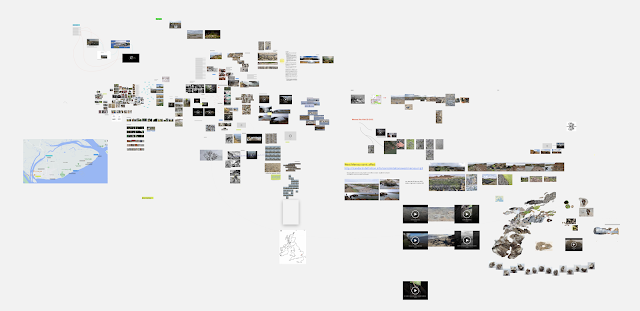PERFORMING MERSEA ISLAND
The MIRO online whiteboard demonstrates the collaboration between individual and collective sensingsite activities performing Mersea Island. It contains text, images, sound, and video, which can be navigated as an interactive map of the group’s activity. Click on the image above to enter.
Sensingsite’s latest project is a collective response to the material and sensory nature of Mersea Island, Essex. We were first introduced to the island, located in the Colne Estuary just south of Colchester, through the Museum of London Archaeology (MOLA), and began our work in early 2020. As initial access was restricted by the Coronavirus lockdown, we conducted visits using Google Street View, which immediately introduced a critical awareness of differing techniques of media representation. Our subsequent and ongoing use of online Miro Boards as a dynamic platform for sharing material and ideas has become key to our working process, together with physical visits to the site. The physical and tactile act of walking the shoreline of Mersea Island for example, is a way of exploring the impossibility of establishing a concrete, continuous and solid border that defines a body of land as an island.
Our experiments with acts of being in place, our research and group workshops have exposed multiple interests: of materialities, surfaces, and topologies; consideration of the ground and its relative scales, the pathways and boundaries that transect it, the porosity, holes, and gaps of the dynamic shoreline; the rhythm and patterns of processes at work, and the relative speeds of time - recent and distant archaeologies. Mersea Island is a dynamic and changing place with its constantly shifting outline. Climate change and sea level rise is already evident – sea defences on the southern side have been spectacularly breached as part of a 'managed realignment' of the coastline and intertidal hinterland. This has become a focus for our recent activities.
This island is an animate and affective site, but it can also be a drawing machine or a performing agency which we tap into. The tools and technologies we use are extensions of ourselves, such as choreographed multi-camera recordings attached to bodies as they track grounds, or using our bodies as instruments of sound, as acts of respiration - drawing breath, for example, gives voice to sound, ‘atmosphere' moves from sky to mood.
This collective processual approach is a methodology that can be used further afield, to address other sites, to question fixed identifications of place, and challenge notions of ground and materiality as inert and enduring. In our practice we consider site and self-similarity: how we discover, reflect, recognise, and orientate ourselves. Organisational aesthetics (the way we work together) unites psycho-mechanics and environmental dynamics - the workings of internal and external worlds. In this way, the way we go about making art is the art.

